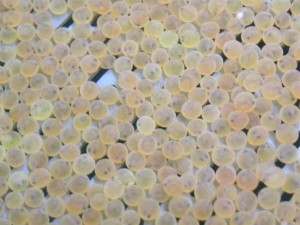January 7, 2013 at 3:51 pm
[caption id="attachment_377" align="alignleft" width="300"] Fish eggs incubating.[/caption]
As you may recall, one of my earlier entries was about the salmon egg take at the Raymond fish trap, posted on November 26, 2012. The following day, Dry Mills hatchery in Gray collected eggs from their Kennebago strain brook trout. The brook trout eggs, like the salmon eggs, were taken via the “dry spawn” method, in which the eggs are collected in a relatively dry bowl, milt is added and mixed for fertilization, and then the eggs are placed in water where they will water-harden for at least an hour. This method allows for a higher percentage of the eggs to become fertilized. Fish eggs begin to harden when they hit the water, so if the eggs and milt are mixed out of the water as opposed to directly in the water, more eggs are fertilized before they have hardened.
After hardening for an hour, the brook trout eggs were placed into jars, where they would sit with clean spring water cycling in the jars until the eggs have ‘eyed’. The jar process allows healthy, living eggs to settle into the bottom while the dead eggs rise to the top, allowing for easier removal of dead eggs. The cycling of clean water helps prevent some fungal growth, mimics the natural running water of streams, and keeps the eggs well-oxygenated. In the time between the taking of the eggs and the embryos growing to the ‘eyed’ stage, the eggs are very fragile, and the less handling of them in those early stages the better. Thus, when the eggs reach the ‘eyed’ stage, it is a significant step in the hatchery. For brook trout, it takes about 30 days with an average water temperature of 10C for the eggs to reach the eyed stage. They may develop faster if the water is slightly warmer, or slower if the water is slightly cooler.
[caption id="attachment_376" align="alignleft" width="300"]
Fish eggs incubating.[/caption]
As you may recall, one of my earlier entries was about the salmon egg take at the Raymond fish trap, posted on November 26, 2012. The following day, Dry Mills hatchery in Gray collected eggs from their Kennebago strain brook trout. The brook trout eggs, like the salmon eggs, were taken via the “dry spawn” method, in which the eggs are collected in a relatively dry bowl, milt is added and mixed for fertilization, and then the eggs are placed in water where they will water-harden for at least an hour. This method allows for a higher percentage of the eggs to become fertilized. Fish eggs begin to harden when they hit the water, so if the eggs and milt are mixed out of the water as opposed to directly in the water, more eggs are fertilized before they have hardened.
After hardening for an hour, the brook trout eggs were placed into jars, where they would sit with clean spring water cycling in the jars until the eggs have ‘eyed’. The jar process allows healthy, living eggs to settle into the bottom while the dead eggs rise to the top, allowing for easier removal of dead eggs. The cycling of clean water helps prevent some fungal growth, mimics the natural running water of streams, and keeps the eggs well-oxygenated. In the time between the taking of the eggs and the embryos growing to the ‘eyed’ stage, the eggs are very fragile, and the less handling of them in those early stages the better. Thus, when the eggs reach the ‘eyed’ stage, it is a significant step in the hatchery. For brook trout, it takes about 30 days with an average water temperature of 10C for the eggs to reach the eyed stage. They may develop faster if the water is slightly warmer, or slower if the water is slightly cooler.
[caption id="attachment_376" align="alignleft" width="300"] Brook trout eggs at the 'eyed' stage.[/caption]
Once the eggs are at that stage, they are more resilient, and can be handled more without detriment. The eggs are moved from the jars to the incubation trays, with hatchery personnel picking out dead eggs daily. This keeps the living ones healthy, as dead eggs left sitting tend to attract fungal growths. With about 5 million eggs in the state hatchery system currently (1.2 million eggs at the Dry Mills hatchery alone), picking eggs and tending these future fighters is a tedious, time-consuming job. The sac-fry, or alevins, should be hatching from the first eggs that were taken in Palermo and transferred to Dry Mills any day, and the Kennebago eggs should be hatching in about 1-2 weeks, when we will check in on them again and update you with their progress!
For more information about the fish rearing process, check out our Hatchery Division page at the top of this blog.
Brook trout eggs at the 'eyed' stage.[/caption]
Once the eggs are at that stage, they are more resilient, and can be handled more without detriment. The eggs are moved from the jars to the incubation trays, with hatchery personnel picking out dead eggs daily. This keeps the living ones healthy, as dead eggs left sitting tend to attract fungal growths. With about 5 million eggs in the state hatchery system currently (1.2 million eggs at the Dry Mills hatchery alone), picking eggs and tending these future fighters is a tedious, time-consuming job. The sac-fry, or alevins, should be hatching from the first eggs that were taken in Palermo and transferred to Dry Mills any day, and the Kennebago eggs should be hatching in about 1-2 weeks, when we will check in on them again and update you with their progress!
For more information about the fish rearing process, check out our Hatchery Division page at the top of this blog.
 Fish eggs incubating.[/caption]
As you may recall, one of my earlier entries was about the salmon egg take at the Raymond fish trap, posted on November 26, 2012. The following day, Dry Mills hatchery in Gray collected eggs from their Kennebago strain brook trout. The brook trout eggs, like the salmon eggs, were taken via the “dry spawn” method, in which the eggs are collected in a relatively dry bowl, milt is added and mixed for fertilization, and then the eggs are placed in water where they will water-harden for at least an hour. This method allows for a higher percentage of the eggs to become fertilized. Fish eggs begin to harden when they hit the water, so if the eggs and milt are mixed out of the water as opposed to directly in the water, more eggs are fertilized before they have hardened.
After hardening for an hour, the brook trout eggs were placed into jars, where they would sit with clean spring water cycling in the jars until the eggs have ‘eyed’. The jar process allows healthy, living eggs to settle into the bottom while the dead eggs rise to the top, allowing for easier removal of dead eggs. The cycling of clean water helps prevent some fungal growth, mimics the natural running water of streams, and keeps the eggs well-oxygenated. In the time between the taking of the eggs and the embryos growing to the ‘eyed’ stage, the eggs are very fragile, and the less handling of them in those early stages the better. Thus, when the eggs reach the ‘eyed’ stage, it is a significant step in the hatchery. For brook trout, it takes about 30 days with an average water temperature of 10C for the eggs to reach the eyed stage. They may develop faster if the water is slightly warmer, or slower if the water is slightly cooler.
[caption id="attachment_376" align="alignleft" width="300"]
Fish eggs incubating.[/caption]
As you may recall, one of my earlier entries was about the salmon egg take at the Raymond fish trap, posted on November 26, 2012. The following day, Dry Mills hatchery in Gray collected eggs from their Kennebago strain brook trout. The brook trout eggs, like the salmon eggs, were taken via the “dry spawn” method, in which the eggs are collected in a relatively dry bowl, milt is added and mixed for fertilization, and then the eggs are placed in water where they will water-harden for at least an hour. This method allows for a higher percentage of the eggs to become fertilized. Fish eggs begin to harden when they hit the water, so if the eggs and milt are mixed out of the water as opposed to directly in the water, more eggs are fertilized before they have hardened.
After hardening for an hour, the brook trout eggs were placed into jars, where they would sit with clean spring water cycling in the jars until the eggs have ‘eyed’. The jar process allows healthy, living eggs to settle into the bottom while the dead eggs rise to the top, allowing for easier removal of dead eggs. The cycling of clean water helps prevent some fungal growth, mimics the natural running water of streams, and keeps the eggs well-oxygenated. In the time between the taking of the eggs and the embryos growing to the ‘eyed’ stage, the eggs are very fragile, and the less handling of them in those early stages the better. Thus, when the eggs reach the ‘eyed’ stage, it is a significant step in the hatchery. For brook trout, it takes about 30 days with an average water temperature of 10C for the eggs to reach the eyed stage. They may develop faster if the water is slightly warmer, or slower if the water is slightly cooler.
[caption id="attachment_376" align="alignleft" width="300"] Brook trout eggs at the 'eyed' stage.[/caption]
Once the eggs are at that stage, they are more resilient, and can be handled more without detriment. The eggs are moved from the jars to the incubation trays, with hatchery personnel picking out dead eggs daily. This keeps the living ones healthy, as dead eggs left sitting tend to attract fungal growths. With about 5 million eggs in the state hatchery system currently (1.2 million eggs at the Dry Mills hatchery alone), picking eggs and tending these future fighters is a tedious, time-consuming job. The sac-fry, or alevins, should be hatching from the first eggs that were taken in Palermo and transferred to Dry Mills any day, and the Kennebago eggs should be hatching in about 1-2 weeks, when we will check in on them again and update you with their progress!
For more information about the fish rearing process, check out our Hatchery Division page at the top of this blog.
Brook trout eggs at the 'eyed' stage.[/caption]
Once the eggs are at that stage, they are more resilient, and can be handled more without detriment. The eggs are moved from the jars to the incubation trays, with hatchery personnel picking out dead eggs daily. This keeps the living ones healthy, as dead eggs left sitting tend to attract fungal growths. With about 5 million eggs in the state hatchery system currently (1.2 million eggs at the Dry Mills hatchery alone), picking eggs and tending these future fighters is a tedious, time-consuming job. The sac-fry, or alevins, should be hatching from the first eggs that were taken in Palermo and transferred to Dry Mills any day, and the Kennebago eggs should be hatching in about 1-2 weeks, when we will check in on them again and update you with their progress!
For more information about the fish rearing process, check out our Hatchery Division page at the top of this blog.Categories